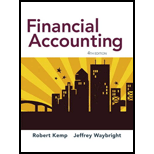
Financial Accounting
4th Edition
ISBN: 9780134125053
Author: Kemp, Robert S., Waybright, Jeffrey.
Publisher: Pearson Education,
expand_more
expand_more
format_list_bulleted
Concept explainers
Question
Chapter 2, Problem 10SC
To determine
Identify which of given
Expert Solution & Answer
Want to see the full answer?
Check out a sample textbook solution
Students have asked these similar questions
General Accounting question please solve and correct answer
What is the labor efficiency variance for March on these general accounting question?
If a business has revenue of $677,000, cost of goods sold of $214,000, operating expenses of $157,000, and pays $70,000 in taxes, what is the net income? Accounting
Chapter 2 Solutions
Financial Accounting
Ch. 2 - The order in which assets were listed and...Ch. 2 - Prob. 2DQCh. 2 - How is revenue related to retained earnings?Ch. 2 - Prob. 4DQCh. 2 - Prob. 5DQCh. 2 - Prob. 6DQCh. 2 - Prob. 7DQCh. 2 - Distinguish between journalizing and posting.Ch. 2 - True or false: If the trial balance is in balance,...Ch. 2 - When it is time to prepare the financial...
Ch. 2 - Which sequence of actions correctly summarizes the...Ch. 2 - Prob. 2SCCh. 2 - Prob. 3SCCh. 2 - Prob. 4SCCh. 2 - Prob. 5SCCh. 2 - Which journal entry records obtaining a bank loan...Ch. 2 - RV Wholesale, Inc., paid 1,200 for supplies and...Ch. 2 - Prob. 8SCCh. 2 - Prob. 9SCCh. 2 - Prob. 10SCCh. 2 - Prob. 11SCCh. 2 - Prob. 12SCCh. 2 - Prob. 1SECh. 2 - Prob. 2SECh. 2 - Prob. 3SECh. 2 - Prob. 4SECh. 2 - Accounting terminology (Learning Objectives 2, 3, ...Ch. 2 - Effects of debits and credits on accounts...Ch. 2 - Balancing accounts and normal balances (Learning...Ch. 2 - Types of accounts and effects of debits and...Ch. 2 - Prob. 9SECh. 2 - Journalizing transactions (Learning Objective 3)...Ch. 2 - Prob. 11SECh. 2 - Prob. 12SECh. 2 - Prob. 13SECh. 2 - Accounting terminology (Learning Objectives 1, 2,...Ch. 2 - Prob. 15AECh. 2 - Journalizing transactions (Learning Objective 3)...Ch. 2 - Prob. 17AECh. 2 - Prob. 18AECh. 2 - Prob. 19AECh. 2 - Prob. 20AECh. 2 - Prob. 21AECh. 2 - Prob. 22AECh. 2 - Prob. 23BECh. 2 - Prob. 24BECh. 2 - Prob. 25BECh. 2 - Prob. 26BECh. 2 - Prob. 27BECh. 2 - Prob. 28BECh. 2 - Prob. 29BECh. 2 - Prob. 30BECh. 2 - Prob. 31APCh. 2 - Prob. 32APCh. 2 - Prob. 33APCh. 2 - Prob. 34APCh. 2 - Prob. 35APCh. 2 - Prob. 36APCh. 2 - Prob. 37BPCh. 2 - Prob. 38BPCh. 2 - Prob. 39BPCh. 2 - Prob. 40BPCh. 2 - Prob. 41BPCh. 2 - Prob. 42BPCh. 2 - Prob. 1CECh. 2 - Prob. 1CPCh. 2 - Prob. 1CFSAPCh. 2 - Prob. 1EIACh. 2 - Prob. 2EIACh. 2 - Prob. 1FACh. 2 - Prob. 1IACh. 2 - Prob. 1SBACh. 2 - Prob. 1WC
Knowledge Booster
Learn more about
Need a deep-dive on the concept behind this application? Look no further. Learn more about this topic, accounting and related others by exploring similar questions and additional content below.Similar questions
- Find Standard rate hourarrow_forwardThe cost of goods sold is found on which financial statement? (1) Income Statement (2) Balance Sheet (3) Statement of Retained Earnings (4) Statement of Cash Flowsarrow_forward1) Turquoise Inc. leased a large machine from Teal Co for four years. The lease contract provided that at the end of the term of the lease Turquoise may opt to purchase the machine for an amount significantly less than its fair value to be, and it is highly probable that Turquoise would purchase it. The machine is estimated to have two additional years of economic use after the purchase. How would Turquoise figure how much to amortize its right-of-use asset? A Lease expense minus interest on the initial carrying value of the lease liability B Lease expense minus interest on the current carrying value of the lease liability C Initial carrying value of the lease liability divided by six years D Initial carrying value of the lease liability divided by four years 2) As of December 31, 2024, Maroon Inc. had 50,000 shares of its common stock outstanding and reported net income for the year $350,000. Maroon also had 4,000 stock warrants outstanding, allowing the purchase of 10 shares each at…arrow_forward
- On July 1, the accounts receivable account balance was $77,500. During July, $335,000 was collected from customers on account. Assuming the July 31 balance was $75,400, determine the fees billed to customers on account during July.arrow_forwardFinancial Accounting Question please provide solutionarrow_forwardFinancial accountingarrow_forward
arrow_back_ios
SEE MORE QUESTIONS
arrow_forward_ios
Recommended textbooks for you
 Financial And Managerial AccountingAccountingISBN:9781337902663Author:WARREN, Carl S.Publisher:Cengage Learning,
Financial And Managerial AccountingAccountingISBN:9781337902663Author:WARREN, Carl S.Publisher:Cengage Learning, College Accounting, Chapters 1-27AccountingISBN:9781337794756Author:HEINTZ, James A.Publisher:Cengage Learning,
College Accounting, Chapters 1-27AccountingISBN:9781337794756Author:HEINTZ, James A.Publisher:Cengage Learning,- Principles of Accounting Volume 1AccountingISBN:9781947172685Author:OpenStaxPublisher:OpenStax CollegeCentury 21 Accounting Multicolumn JournalAccountingISBN:9781337679503Author:GilbertsonPublisher:Cengage

Financial And Managerial Accounting
Accounting
ISBN:9781337902663
Author:WARREN, Carl S.
Publisher:Cengage Learning,


College Accounting, Chapters 1-27
Accounting
ISBN:9781337794756
Author:HEINTZ, James A.
Publisher:Cengage Learning,

Principles of Accounting Volume 1
Accounting
ISBN:9781947172685
Author:OpenStax
Publisher:OpenStax College

Century 21 Accounting Multicolumn Journal
Accounting
ISBN:9781337679503
Author:Gilbertson
Publisher:Cengage

The accounting cycle; Author: Alanis Business academy;https://www.youtube.com/watch?v=XTspj8CtzPk;License: Standard YouTube License, CC-BY